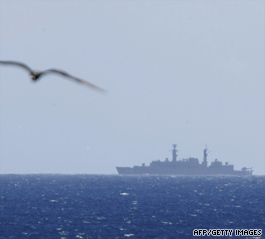 PARIS, France (CNN) -- The bodies of two men, one of whom was confirmed to be a passenger from the Air France plane that crashed Monday, were found early Saturday, a Brazilian air force spokesman said.
PARIS, France (CNN) -- The bodies of two men, one of whom was confirmed to be a passenger from the Air France plane that crashed Monday, were found early Saturday, a Brazilian air force spokesman said.Also found were a backpack and a leather briefcase containing an airplane ticket with a reservation code, which Air France verified belonged to a passenger on the jet, Jorge Amaral said.
The Brazilian navy and air force said the backpack contained a laptop, and an oxygen mask also was discovered, the Brazilian navy and air force said.
Air force officials announced the news in Recife, Brazil. The items were discovered 420 miles north of the Fernando de Noronha islands, 220 miles (355 kilometers) off the northeast coast of Brazil.
All 228 passengers and crew aboard the Airbus 330 are presumed to have died when the plane disappeared northeast of the islands.
The flight originated in Rio de Janeiro, Brazil, and was en route to Paris, France.
Search teams were still trying to find debris from the jet Saturday, two days after an air force official said debris plucked from the ocean was not from the Air France jet.
Earlier Saturday, aviation investigators said Flight 447 sent out 24 automated error messages, including one saying the aircraft's autopilot had disengaged, before it vanished with 228 people on board.
They also reported that the airline had failed to replace a part, as recommended by the manufacturer, Airbus.
Airbus had advised airlines to update equipment that monitors speed, known as Pitot tubes. The recommendation was a result of technological developments and improvements, an Airbus spokesman told CNN's Richard Quest. The change was not mandatory, and the spokesman would not comment on Air France's failure to follow the advice.
Planes have crashed because of faulty or blocked Pitot tubes in the past, Quest said, and there was clearly something wrong with the doomed plane's speed-monitoring equipment.
But it may be a mistake to place too much emphasis on the Pitot tubes, he added, as the jet apparently was experiencing massive system failures.
Even as they analyzed the error messages and satellite images of the doomed flight's path, investigators said they still have a lot of work to determine what caused the plane to go down.
"I would just like to ask you to bear in mind that all of this is dynamic and there are a lot of question marks," said Paul-Louis Arslanian, head of France's accident investigation bureau.
"We don't know how the aircraft entered the water. We don't know how these pieces of debris entered into the water and that you have to take into account the current ... and the shape of the ocean floor."
The error messages suggest that the plane may have been flying too fast or too slow through the stormy weather it encountered before the crash, officials said.
In addition, investigators have said the plane's autopilot disengaged, cabin pressure was lost, and there was an electrical failure before the disaster.
The jet's manufacturer, Airbus, sent a Telex to operators of Airbus models reminding them of what to do when speed indicators give conflicting readings.
The spokesman said the notice does not mean there is any major flaw in the aircraft but is simply a reminder to pilots of what to do in the cockpit if they get conflicting information about air speed.















No comments:
Post a Comment